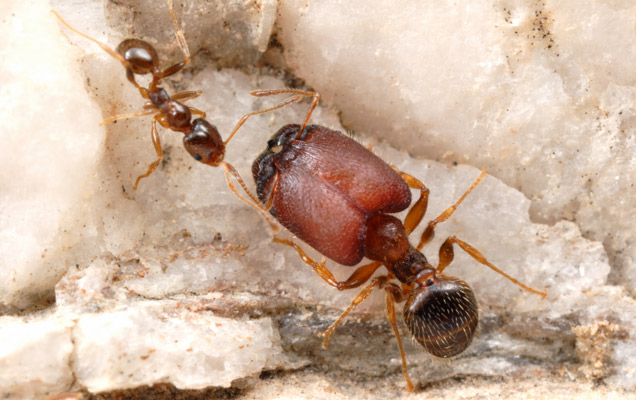We're open daily! View holiday hours
Science News
Superants & Fracking Quakes
January 6, 2012

The first week of 2012 has already packed a wallop with science news stories. Here are a few we didn’t want you to miss.
Super Ants and Ballsy Spiders
Researchers at McGill University have been busy making super ants—well, kind of. It’s known that certain ant species (8 out of 1,100) of the genus Pheidole, produce the occasional supersoldier ant that protects the ant nest from invader ants by blocking the entrance with its giant head.
Well, Canadian researchers discovered the gene mechanism that creates these supersoldiers and pumped it into Pheidole species that normally don’t produce supersoldiers. And voilà! Brand-new supersoldiers!
The research was published yesterday in Science. For more information, check out this article in Nature News.
Last month, a study in Naturwissenschaften demonstrated how male Nephilengys malabarensis spiders continue their aggressive behavior even after losing their genitals during copulation. Read more about these tough guys at New Scientist.
Fracking Earthquake!
Scientists have determined that a 4.0 earthquake in Ohio on New Year’s Eve was indeed caused by fracking. Scientific American specifies:
not from drilling into deep shale or cracking it with pressured water and chemicals to retrieve natural gas. Rather, they [the scientists] suspect the disposal of wastewater from those operations, done by pumping it back down into equally deep sandstone.
NPR offers more information and possible solutions to the problem.
SETI-Kepler Results
SETI (Search for Extraterrestrial Intelligence) has been taking a look (a listen, really) at some of the planets Kepler spotted last year, searching for alien radio signals. They released some of their preliminary results and as the Bad Astronomer puts it in Discover, “No, SETI has not detected an alien signal from a Kepler planet.”
Universe Today reports:
…some interesting signals have been found… but as they [SETI scientists] are quick to point out, these signals so far can all be explained by terrestrial interference… They do, however, also share characteristics which would be expected of alien artificial signals.
The Bad Astronomer’s take:
Well hold on there, buckaroo. There is another source of artificial signals from space: us. We have lots of satellites orbiting the Earth, and they broadcast quite loudly in radio waves.
So no aliens… this time, anyway.
Image: Alex Wild/alexanderwild.com